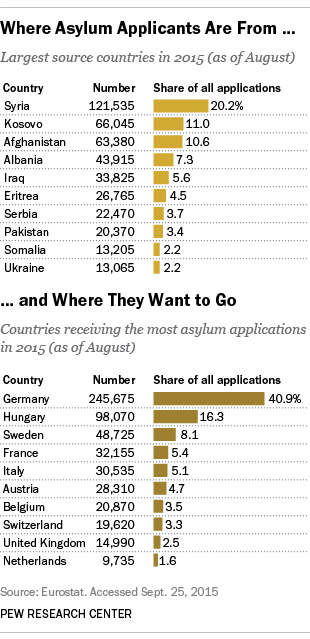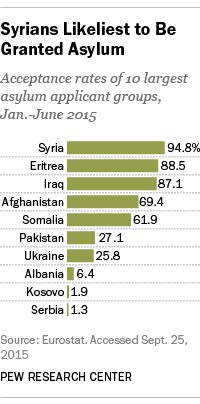
The European Union is still struggling to come up with a systematic way to both manage the unprecedented numbers of refugees streaming across its borders and try to keep more from coming. But even as tens of thousands of Syrians, Iraqis, Afghans and others continue flooding into Europe, they’ll likely find that applying for asylum and getting permission to stay are two very different things.
We looked at data compiled by Eurostat, the EU’s statistical agency, on asylum applications to the 28 nations in the bloc (along with four other European countries that follow the EU’s rules for handling asylum requests). So far this year, according to the data, migrants have their best chance of gaining asylum if they (a) are from Syria, Eritrea or Iraq, and (b) apply in Bulgaria, Denmark or Malta.
Although the Eurostat data run only through part of August, they show that more than 600,000 people have applied for asylum in EU countries so far this year – 58% more than applied in the first eight months of 2014, and just shy of last year’s total of 662,000. (It’s important to note that the Eurostat figures only count people who have formally applied for asylum. Under EU law, asylum seekers generally are supposed to apply in the first EU country they enter, but thousands upon thousands are crossing southern and eastern Europe trying to reach more preferred destinations, such as Germany or Sweden, that have a more welcoming stance toward migrants and offer more benefits and job prospects.)

Syrians are the biggest single group of asylum applicants this year, comprising about 20% of the total (though some refugees from other countries reportedly are claiming to be Syrian, in the hopes of improving their chances of gaining asylum). More than half the asylum seekers, in fact, are from just five countries: Syria, Kosovo, Afghanistan, Albania and Iraq. Most (72%) are male, and more than half (54%) are ages 18 to 34; men in that age bracket account for fully 43% of asylum applicants.
Germany was by far the top destination for migrants seeking asylum: Nearly 41% of all asylum applicants this year (more than 245,000) applied in Germany. Hungary had the second-most asylum applicants, about 98,000 (16.3% of the total), though that may have more to do with the country’s geographic position as a gateway to central and western Europe than with its attitude toward migrants.
But migrants applying for asylum in Germany might have better luck elsewhere. Germany approved fewer than half (43.5%) of the asylum applications it processed in the first half of this year, putting it in the middle of the pack in terms of acceptance rates among European countries. The highest acceptance rates generally were in smaller countries, particularly the Scandinavian nations (Denmark, 85.2%; Sweden, 74.2%; Norway, 72.5%), while the lowest rates were all in former Soviet bloc nations (Latvia, 8.3%; Hungary, 12.3%; Poland, 14.6%).

Migrants fleeing active conflict zones had the best chance of winning asylum, according to decision data from the first half of 2015. Among the largest refugee groups by nationality, nearly all (94.8%) of those claiming Syrian citizenship succeeded in obtaining asylum, followed by Eritreans (88.5%) and Iraqis (87.1%). On the other hand, the large numbers of applicants from the Balkans, which has been mostly at peace since 2001, had less success: Only 6.4% of Albanians, 1.9% of Kosovars and 1.3% of Serbs gained EU asylum in the first half of this year.
